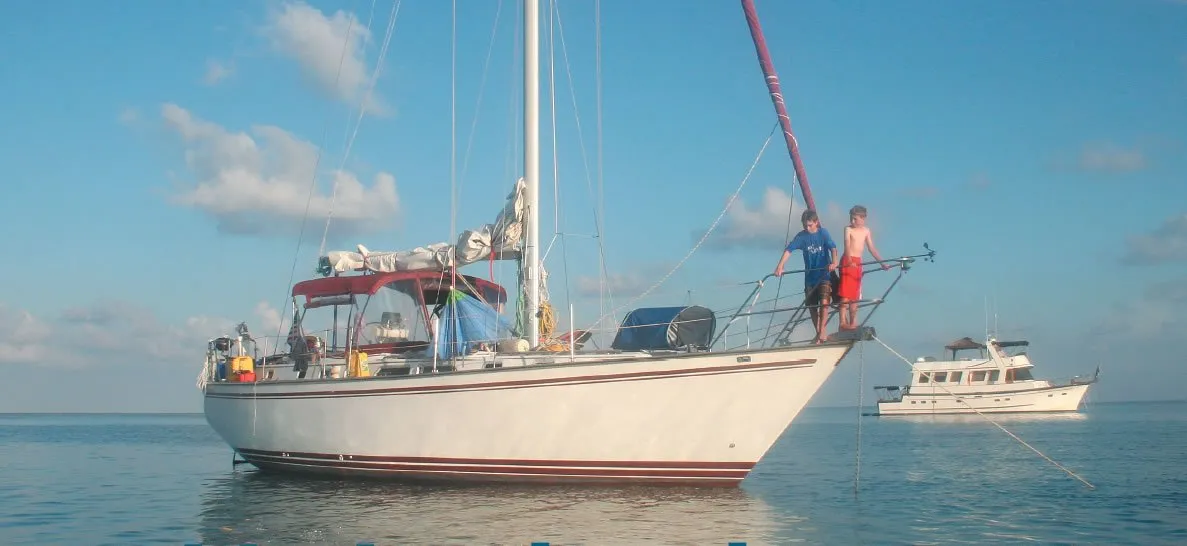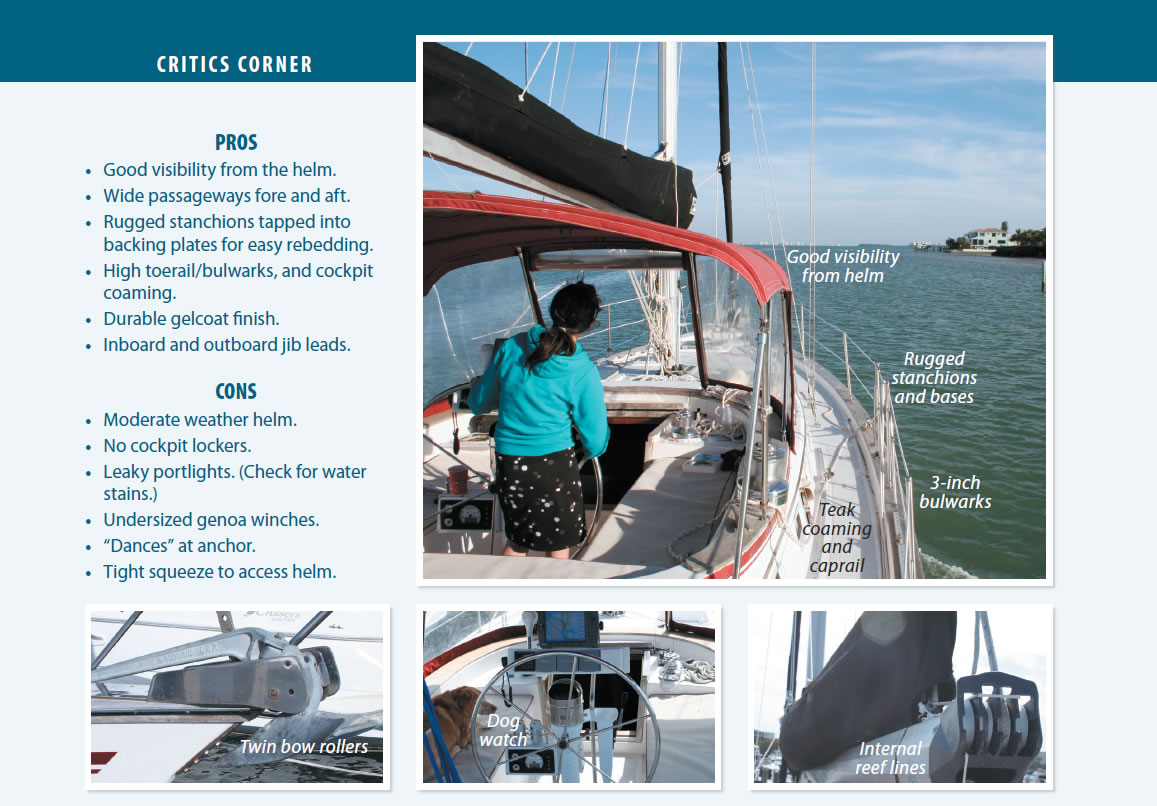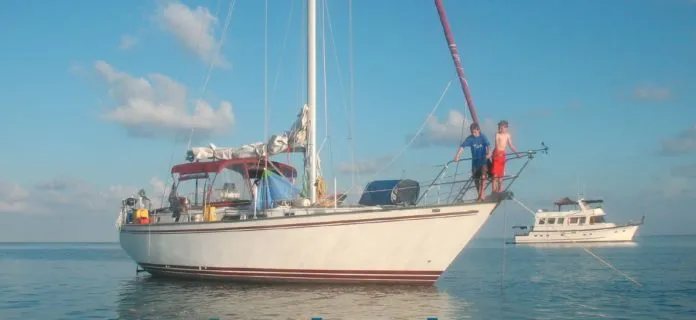Just as the Caribbean cruising dream was at its peak in the American consciousness, Endeavour yachts brought in Americas Cup designer Johan Valentijn to create a new breed of Endeavours to compete with an already crowded field of center-cockpit cruisers, most of them bound for the Caribbean charter trade. The end result was a boat that managed to maintain a surprisingly tolerable aesthetic, unlike the typical wedding-cake center cockpit cruiser. The combination of teak trim, bootstripe, and balanced proportions camouflages what is essentially a floating condo.
True, the boat can sail. With its tall rig and inboard shrouds, it can even beat to windward with a bit of authority, but with a displacement to length ratio of more than 300, the Endeavour 42 is a pure cruiser, designed to get its crew from here to there in relative comfort. The other performance drawback is the four and one-half foot draft. When working to windward, this keel simply can’t provide the lift of deeper, higher-aspect foil keel. However, youd be hard pressed to find anyone complain about shallow draft in Florida, the Bahamas, or the other shoal waters where the boat is popular. Perhaps its biggest attraction is its price-less than $100,000 for a second home on the water.
In our view, however, the most salient point to highlight is that the Endeavour 42 is the boat that Sonny Crockett and his pet crocodile lived on for most of the hit television series Miami Vice. Crockett, played by actor Don Johnson, epitomized the 80s swinging single with a two-day beard. Of the 257 Endeavour 42s built between 1985 and 1991, we guess that roughly half of them are still occupied by single men who are living (or at one-time aspired to) the Sonny Crockett lifestyle. The other half, we would venture, are owned or captained by men, women, and families who are actually doing some sailing. The distinction is important if you are looking for a used Endeavour 42.

Deck layout
In terms of ergonomics, the E42 is fairly efficient, but it is a big boat and the loads are such that older sailors may want to budget for $5,000-$15,000 in upgrades that will reduce friction in the running rigging.
Because of the high mast height and Bimini top, routines like flaking and tending to the mainsail require a little more nimbleness than a typical aft-cockpit cruiser, but lazy jacks and a self-stowing mainsail cover can fix that. The jib sheet winches-self-tailing Lewmar 44s should be one size bigger-but the real sticking point (at least on our test boat) was setting and lowering the mainsail using the lines led aft to the cockpit. A rigid boom vang, a self-stowing mainsail system (Stackpack, Mack-Pack, Dutchman etc.), new turning blocks, and efficient sail slides (Dutchman Strong track) will make setting the main easier. The Lewmar mainsheet traveler on our test boat also could benefit from an upgrade, or at least a rebuild, if you want to make life easier.
Passages fore and aft are clear and wide. The foredeck allows plenty of room to store an 11-foot RIB tender, although many owners have added davits aft. The design came with two different transoms: older models have flat transom, the post-1989 models have an extended transom with an early iteration of the now common scoop transom. Owners unanimously prefer the scoop design, which makes it easier to load and unload from the dinghy, climb aboard when swimming.
The cockpit can be fully enclosed for winter sailing. The boat we sailed had a dodger and side panels. This protected from the elements, but still allowed easy reach to the mainsheet aft. Our test boat had three headsail tracks-two outboard, and one inboard. Leading the sheets lead through the inboard leads may require a turning block aft to prevent chafing on the teak cockpit coaming.
Accommodations
The E42 is a walk-through center cockpit design, meaning that you can access the aft cabin without going above deck. This arrangement reduces the risk of down-flooding, simplifies mainsheet runs, and, is easier on the knees, heart, and self-esteem. Unless you are an emphatic FitBit user, or insist on sound-studio isolation, a walk-through is the way to go in a center-cockpit cruiser.
The walk-through design presents two major challenges: creating enough headroom in the passage aft without building a wedding cake, and locating the passage where it causes the least interference with life below.
Endeavour accomplished the first feat without fuss by eliminating cockpit lockers, however, the passageway is also the galley, an arrangement that might raise hackles of the cook, especially if the first mate is the forgetful type always needing to squeeze past to retrieve his reading glasses. The galleys oversized top-loading freezer fridge is overkill for most cruising needs and the insulation is builders grade, but the size is easily reduced, and insulation can be added. If you’re an avid spear fisherman and the boat has a genset, you’ll be able to feed yourself through a nuclear winter.
One of the biggest advantages of the walkthrough design is excellent access to the engine, which sits directly beneath the cockpit and can be reached through doors on either the side of the engine-from the galley or aft cabin head. In fact, except for the fuel tank, some wiring, and scupper hoses, access to all of the boats key system components is commendable.
The layout is pretty standard for a center cockpit boat-one forward double v-berth, one single settee (starboard), one double convertible settee (port, either a circular or L-shaped dinette), and one island queen berth aft with its own head. The forward berth has a five-foot hanging locker and three drawers under the berth. The owners cabin aft has two hanging lockers and six drawers-three per side.
The guest head forward has two doors (one from the berth, one from the main saloon), however these doors, as well as the forward cabin door, tend to get jammed as the rigging and mast loads are transferred to this area. Reinforcing the doorways with an aluminum frame, as some other builders do, would help prevent this, but most owners just plane the doors to size and carry on. Given the signs of bulkhead flexing we saw on three separate boats, were not surprised that leaks at the mast partners and shroud chainplates are common complaints.
The interior is built mainly of wood, with pan liners for the two heads. The floor timbers are bonded in place with woven roving and the plywood sole is screwed onto these longitudinal and transverse timbers. A teak and holly floor is bonded on top of that. The varnish and joinery on the boat we tested was above average, and owners seem generally pleased with the appearance and layout. This stick-built approach lends itself to modification. The boat we sailed had a full-length bar instead of the starboard settee (the Sonny Crockett Syndrome in full bloom).
Two interior items that drew criticism in our survey were the location of the galley sink, which is tucked beneath galley stairs, and the practicality of the wet bar in the main saloon-which most long-term cruisers have retrofitted for storage, an AC compressor, or fireplace.
The boat is very well ventilated, ideal for the tropics. Multiple Bomar opening ports, two large overhead Atkins and Hoyle hatches in the main cabin, and one large hatch over each double berth provide ample breeze at anchor. (The lack of dorades speaks to its island-hopping rather than ocean-crossing aspirations).
Systems
Most of the boats that we saw have undergone at least some systems overhauls. One of the surprises on our test boat was the scupper hoses. These hoses, which are difficult to inspect because they are hidden behind paneling, had rotted out, allowing the boat to flood with rainwater. The hoses that drain the aft lockers had also rotted out, allowing seawater to enter the boat while it was heeled or motoring. These hoses and through hulls are virtually inaccessible. New owners should cut inspection ports to access these through hulls and consider retrofitting a seacock.
The most common auxilliary is a 62 horsepower Perkins 4-154 diesel engine with 2.5 to 1 reduction gear (1983-1986). Most later model boats (1987-1991) have Yanmar 4JH.
Our test boat had a brand-new, drop-in replacement for the Yanmar 4JH- the extremely quiet, Tier III emissions-compliant Yanmar 4JH57. The new 57 horsepower engine uses electronically controlled common rail injection to precisely regulate of the amount and timing of fuel injection for better fuel efficiency. Burn rate can be instantaneously monitored via the engines displays, or via an NMEA 2000 compliant multi-function display at the helm.
All models have 1.25-inch diameter solid, stainless-steel propeller shafts. The stuffing box is easily accessible from the aft cabin. The standard propeller is a three-blade 17 x 16-inch right-hand propeller.
The fuel tank, located in the keel beneath the engine, is a problem. Built of marine grade aluminum, it is exposed to condensation and water trapped in the bilge that can cause pinholes to develop. If the boat has not yet had the tank replaced, you should budget for this project-$10,000 to $20,000 were the prices we were quoted by owners. Most people cut the tank out from above, which requires major deconstruction. The owner of our test boat is a boat builder, and he accessed by cutting a hole in the side of the keel-a job requiring absolute confidence in the fiberglass repair.
The electrical system is fairly standard for the era. Stranded copper wire leads to AC and DC power panels at the navigation station, which is located just beneath the cockpit stairs facing forward on the starboard side. The wiring on our test boat was not well labeled, nor particularly well organized. An upgrade to NMEA 2000 can fix this, but it will be time-consuming if you want to use the same wire runs.
The wires on our test boat run beneath the side decks, although some wires also run just beneath the floorboards in the bilge. In either case, fishing new wires is not a simple task. The bilge itself has an extremely deep sump just below the cockpit stairs. The owner of our test boat had wisely installed his bilge pump and float valve on a long aluminum extension that allowed him to retrieve it and inspect it as needed. The bronze seacocks are all bonded with 8-gauge wire to prevent galvanic corrosion in salt water.
Performance
The Endeavour 42 enjoys a good breeze, and although a cruising chute can keep it moving in light air, most cruisers opt to motorsail when the winds lighten. We averaged about 6.3 knots on our passage from Sarasota, Florida to Havana, sailing conservatively in winds ranging from 8 to 17 knots.
Being shorthanded, we reefed the main at night, but were still able to maintain between 5.5 and 6 knots. If you are willing to use the engine when needed, you can plan on making 6.5 knots, while burning about 1.5-2 gallons per hour. The 75-gallon fuel tank is small compared to similar models, and limits range to about 300 miles under power.
The boat balances well in 12 knots or less, but once the wind picks up and the boat heels past about 15-degrees, weather helm sets in. The weather helm is not as extreme as it is on other designs, and is usually remedied by reefing the main to reduce heeling.
Owners also report that a well-cut main and a flattening reef will also help ease the weather helm. Tacking angles were 45 degrees or worse. Our best speed off the wind was 7.4 knots in about 17 knot trades. The boats favorite heading is with the wind just aft of the beam.
Although some Endeavour owners advise sailing under a full genoa alone to offset weather helm in high winds, this puts undue tension on the rig and is not a good idea. Better to reef the main, and furl the jib as needed, as the mainsheet tension helps balance rig loads.
Conclusion
The Endeavour 42s modest price, and excellent support from an active owners association makes it a good choice for the single-minded single with the guts for a major refit. Families should concentrate on an already refurbished model.
Its heavy displacement would seem to lend it to ocean voyaging and at least one Endeavour owner routinely takes the offshore route between New England and the islands. Nevertheless, there are enough shortcomings in the design and systems to recommend it principally for coastwise sailing and island hopping.
Pricewise, there are only a few other boats in this same size range that match up in terms of aesthetic, tonnage, and interior volume. If you’re looking to live like Sonny Crockett, the Endeavour 42 will put you right on track. Compare with the Whitby 42/Brewer 12.8/Brewer 44, Hunter Passage 42, Gulfstar 44, CSY 44, and the Morgan Out Island 41.


The Endeavour 42 spacious layout (above) featured a passage way through the galley to the aft cabin. The boats shallow-draft keel appeals to gunkhole cruisers.



































